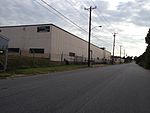Model Tobacco Building

Built from 1938-40, the Art Deco style Model Tobacco Building is the primary six-story building of a six building collection of buildings comprising a former tobacco factory. Located at 1100 Jefferson Davis Highway (U.S. Route 1), in Richmond, Virginia, the building was designed by the Chicago architecture firm of Schmidt, Garden and Erikson and is known for the 9' tall Moderne MODEL TOBACCO letters which dominate the north end of the building. It is one of many Art Deco buildings in Richmond, including assorted buildings on Grace Street including the Central National Bank building, the Virginia Union Belgian Building, Medical College of Virginia's West Hospital, Henrico Theatre, Thomas Jefferson High School (Richmond, Virginia), and Nolde Bakery, 306-308 North 26th Street, and the Patrick Henry Building on 1111 E. Board Street built in 1938-40. Currently the building houses approximately 3.5 acres (14,000 m2) of used cubicle partitions and other miscellaneous office furniture.
Excerpt from the Wikipedia article Model Tobacco Building (License: CC BY-SA 3.0, Authors, Images).Model Tobacco Building
Richmond Highway, Richmond Manchester
Geographical coordinates (GPS) Address External links Nearby Places Show on map
Geographical coordinates (GPS)
| Latitude | Longitude |
|---|---|
| N 37.504777777778 ° | E -77.4476 ° |
Address
Richmond Highway 1100
23224 Richmond, Manchester
Virginia, United States
Open on Google Maps










